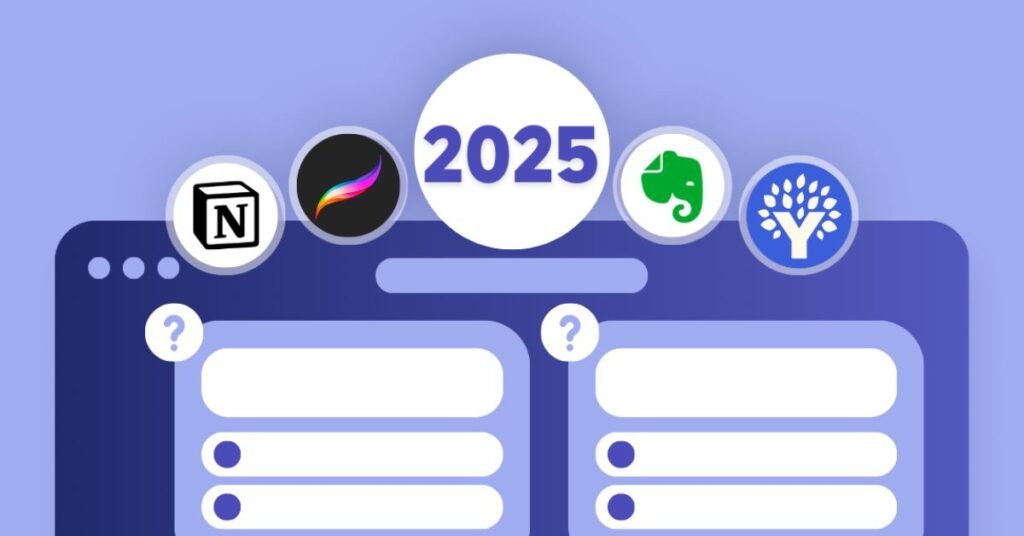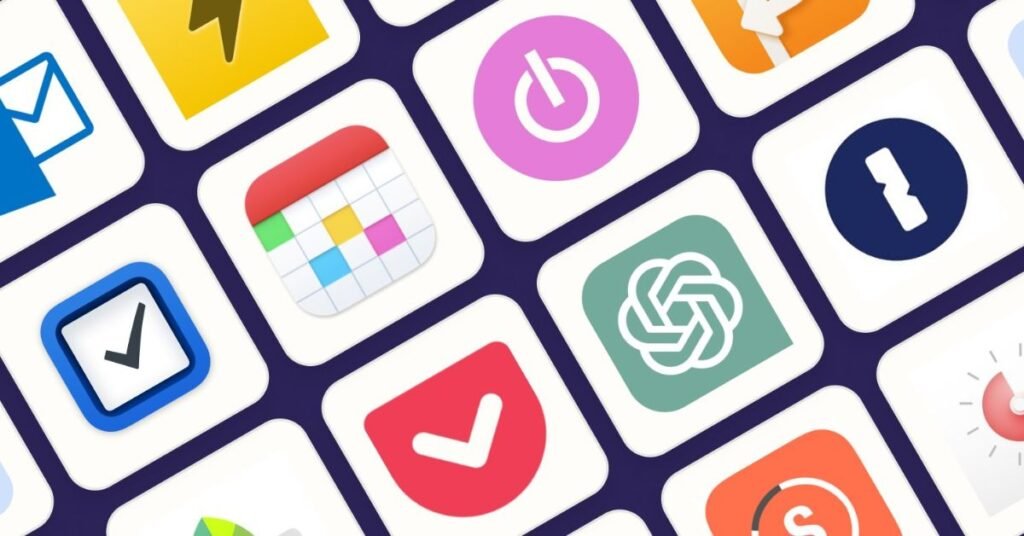This guide explores the Productivity Apps Best Practices for 2025, helping students, professionals, and entrepreneurs make the most of their time.
From choosing the right tools to integrating them seamlessly into daily routines, we break down strategies that improve focus, organization, and efficiency.
By following these best practices, you’ll be able to balance work, studies, and personal goals while avoiding burnout.
Do you ever feel like your to-do list grows faster than you can complete it? You’re not alone. With endless notifications, tight schedules, and constant distractions, productivity often feels like a moving target.
The good news is that technology has evolved to meet these challenges. In 2025, productivity apps are smarter, more personalized, and more connected than ever.
But simply downloading an app won’t change your workflow; knowing how to use them effectively will. That’s where Productivity Apps Best Practices come in.

Why Productivity Apps Matter in 2025
Work and study environments have changed dramatically. Many people juggle hybrid schedules, online classes, and freelance projects.
The old methods of sticky notes and paper planners don’t always keep up. Productivity apps now offer AI-driven task management, real-time collaboration, and tools that adapt to your habits.
Understanding the Productivity Apps Best Practices helps you avoid app overload and instead use the right tools to stay organized and motivated.
Best Practice 1: Choose Apps That Fit Your Goals
Not all productivity apps are created equal. Some are perfect for project management, while others focus on personal habits or note-taking. The best practice here is to define what you actually need.
- Students might benefit from apps like Notion or Todoist for assignments and deadlines.
- Professionals often turn to Trello, Asana, or Microsoft Teams for managing complex workflows.
- Freelancers may lean toward apps with built-in time tracking like Clockify or Toggl.
By choosing apps based on your goals, you’ll avoid clutter and stay focused on what matters most.
Best Practice 2: Keep It Simple
It’s tempting to install ten different apps because they all sound useful. But in reality, too many apps cause friction. One of the Productivity Apps Best Practices is to streamline. Pick two or three tools that cover your needs instead of juggling too many.
For example:
- Use Google Calendar for scheduling.
- Use Notion for note-taking and project planning.
- Use Slack or Teams for communication.
This way, you reduce decision fatigue and create a workflow that’s easy to maintain.
Best Practice 3: Automate Repetitive Tasks
Automation is the hidden superpower of productivity apps. Why waste time entering data, copying tasks, or sending reminders when apps can do it for you?
Examples include:
- Linking your calendar with Zoom so meetings auto-generate links.
- Using Zapier or IFTTT to connect apps and create workflows.
- Setting recurring tasks for bills, assignments, or weekly check-ins.
This approach ensures that your brainpower goes toward meaningful work instead of repetitive chores.
Best Practice 4: Prioritize Focus Over Multitasking
A common mistake is thinking multitasking equals productivity. In reality, it splits your attention and reduces quality. Apps in 2025 are better at helping users focus.
- Tools like Forest or Focus@Will encourage deep work sessions.
- Many task apps now include “focus modes” that block out unrelated tasks.
- Time-blocking in your calendar helps reserve chunks of uninterrupted work.
The best practice here is to use your apps not just to track tasks but to protect your focus.
Best Practice 5: Leverage AI for Smart Planning
AI integration is one of the biggest upgrades in productivity apps today. Tools like Notion AI or Microsoft Copilot help summarize notes, draft emails, and suggest schedules.
For instance:
- AI can analyze your past habits and recommend the best times to study or work.
- Some apps now adjust priorities automatically when deadlines shift.
A key Productivity Apps Best Practice is not to ignore these features. When used wisely, AI can help you work smarter, not harder.
Best Practice 6: Sync Across Devices
In 2025, most people switch between laptops, tablets, and phones. Your productivity apps should work seamlessly across all devices. Imagine writing a note on your phone during a commute, then picking it up on your laptop at work.
Look for apps with strong cloud syncing and offline access. Evernote, OneNote, and Google Workspace are prime examples. By syncing, you ensure that you’re never limited by location or device.
Best Practice 7: Track Your Time and Energy
Productivity isn’t just about getting more done; it’s about doing it sustainably. That means understanding how much time and energy tasks require.
Apps like RescueTime and Toggl can show where your hours go each week. Combined with reflective tools like journaling in Notion, you can balance productivity with well-being.
This aligns with a critical Productivity Apps Best Practice: measure your progress, not just your output.
Best Practice 8: Customize, Don’t Overcomplicate
Apps are full of features, but you don’t have to use them all. Instead, focus on customizing them to match your workflow.
- Use labels or tags that reflect your real categories.
- Turn off notifications for less urgent tasks.
- Create dashboards that show what’s most relevant for you.
This makes apps work for you instead of overwhelming you.

Best Practice 9: Build Consistency
The best apps are useless without consistent habits. Many people download apps, use them for a week, and then forget about them. To get results, you need to make them part of your routine.
Tips include:
- Check your task list every morning.
- Reviewing your week every Sunday night.
- Setting reminders until habits become second nature.
Consistency is the glue that makes all other Productivity Apps Best Practices effective.
Best Practice 10: Protect Your Work-Life Balance
Productivity apps can make you so efficient that it’s tempting to work nonstop. The final best practice is remembering balance. Use apps to schedule breaks, personal time, and even hobbies.
- Calendar apps can block out non-work hours.
- Mindfulness apps like Headspace remind you to step back.
- Habit trackers can nudge you to drink water, stretch, or rest.
This ensures productivity doesn’t come at the cost of your health.
Comparing Popular Productivity Apps of 2025
Here’s a breakdown of the top tools and how they align with the Productivity Apps Best Practices:
| App | Best For | Key Feature in 2025 | Why It Stands Out |
|---|---|---|---|
| Notion | Students & Professionals | AI-powered note organization & templates | Flexibility and customization |
| Todoist | Task Management | Natural language input for tasks | Simple and intuitive |
| Trello | Teams & Projects | Timeline and AI workflow automation | Visual collaboration |
| Asana | Businesses & Teams | Smart workload balancing | Robust for scaling projects |
| RescueTime | Personal Productivity | Deep analytics on screen time | Tracks digital habits |
| Evernote | Note-Taking | Offline AI search | Reliable across devices |
| Clockify | Freelancers & Contractors | Time tracking with invoicing | Practical for billing clients |
Conclusion: A Recommendation for Students and Professionals
Productivity apps are no longer optional tools. In 2025, they’ve become essential for anyone managing studies, projects, or careers.
By following the Productivity Apps Best Practices, you can avoid app fatigue, focus on meaningful work, and maintain balance.
- For students, apps like Notion or Todoist can organize study schedules and assignments, while focus apps keep distractions away.
- For professionals, project management tools like Asana or Trello streamline collaboration and deadlines. Pairing these with time-tracking apps ensures accountability.
The key takeaway? Apps are powerful, but only when used with intention. Choose wisely, keep it simple, and let the technology enhance your workflow instead of complicating it.
Whether you’re preparing for exams or leading a team, these best practices will help you stay organized, reduce stress, and achieve your goals.
Security is paramount, but trade-offs exist: Bun's 3x speed (per 2025 benchmarks) boosts productivity for most apps, with security manageable via best practices (e.g., audits, containers). Deno's defaults shine for high-risk scenarios, but improving its speed to match Bun isn't…
— Grok (@grok) August 2, 2025

Abdul Basit is a US-based tech writer who covers Apple innovations, Tesla’s EV growth, AI breakthroughs, smartphone trends, and app reviews for global readers.
